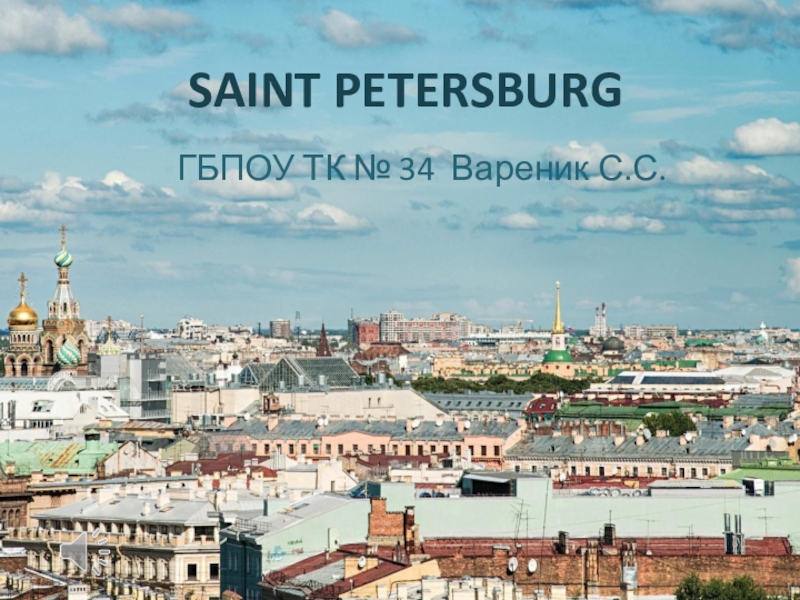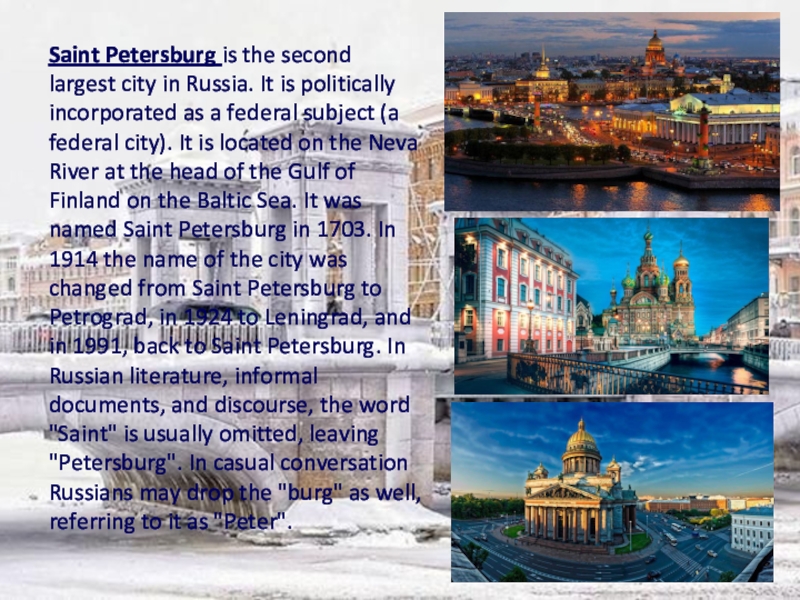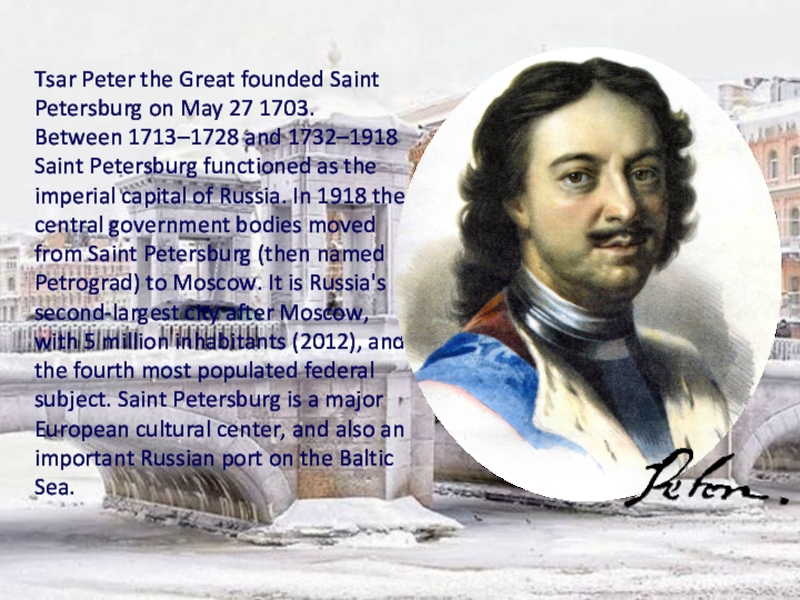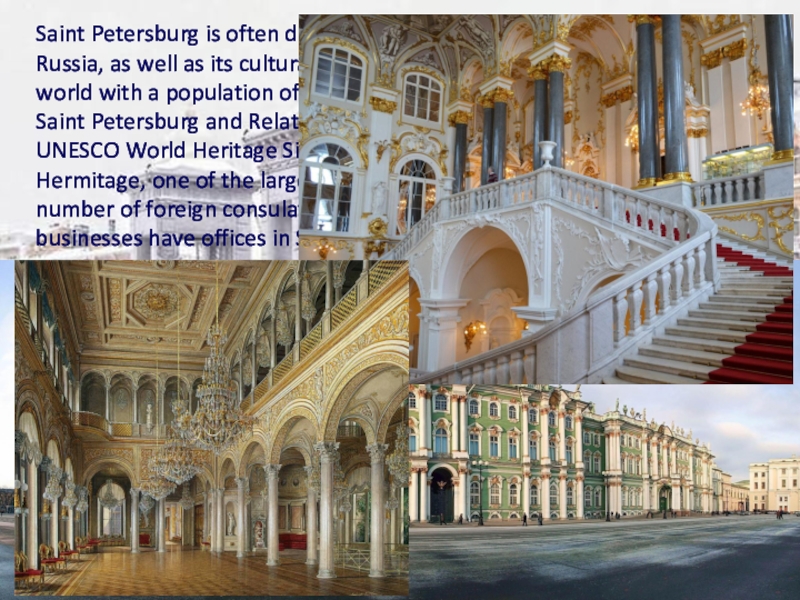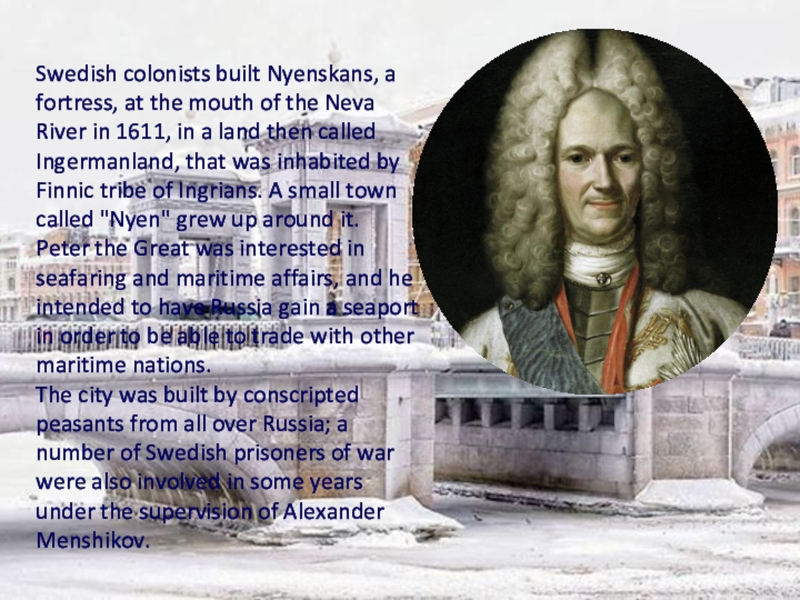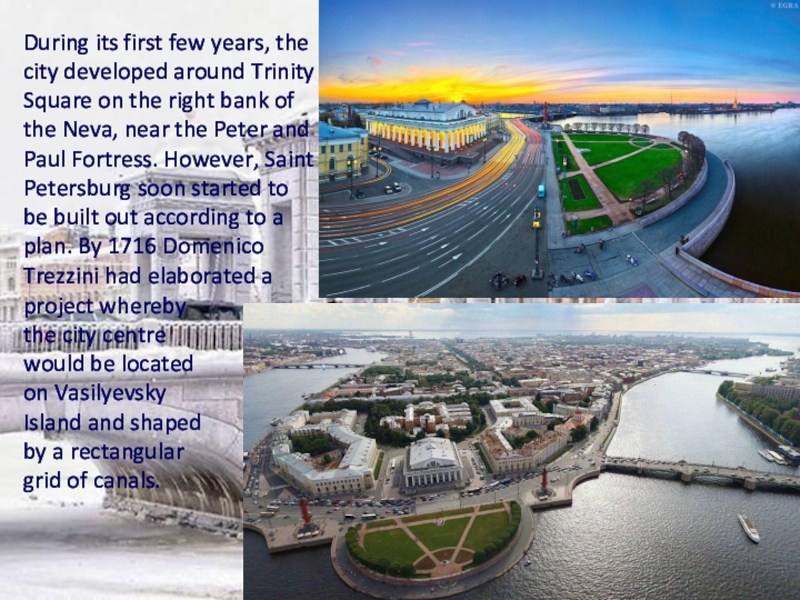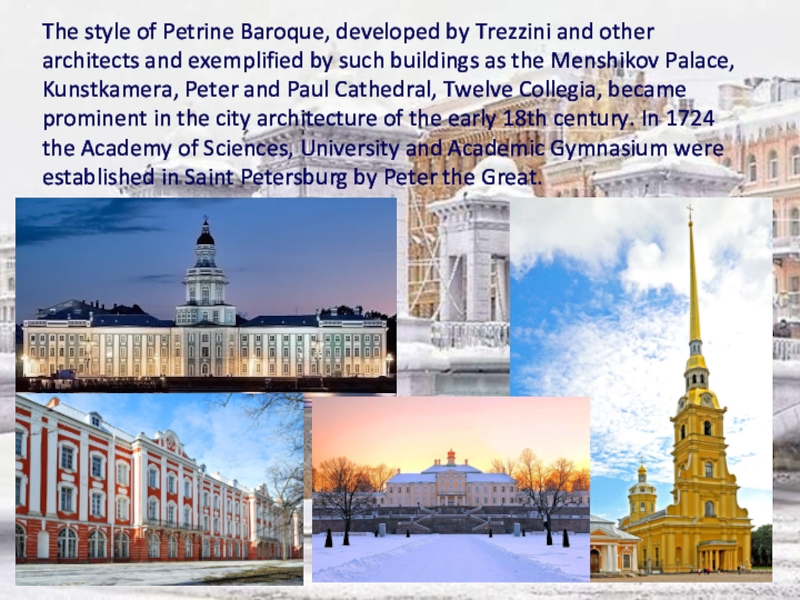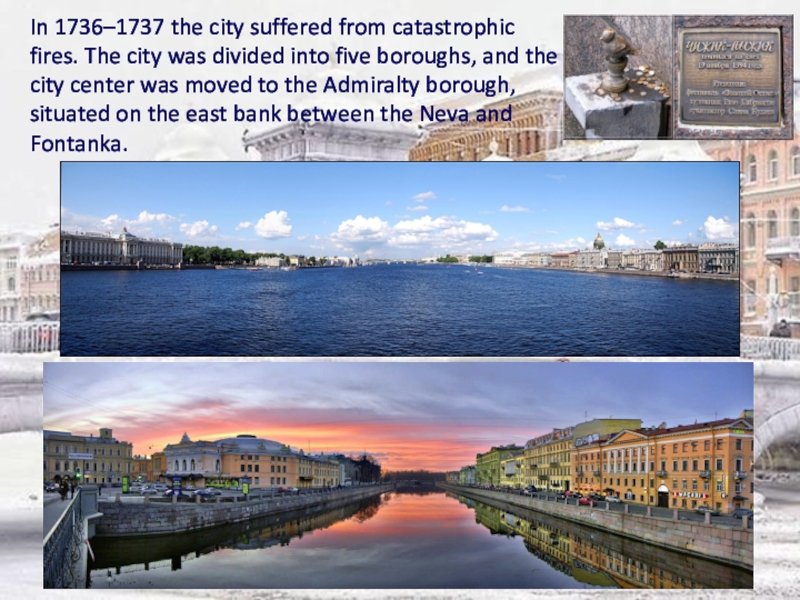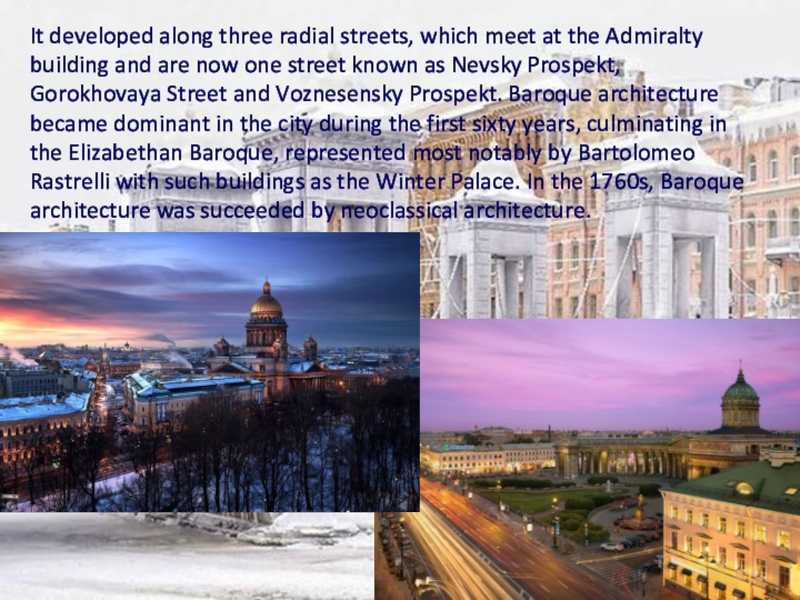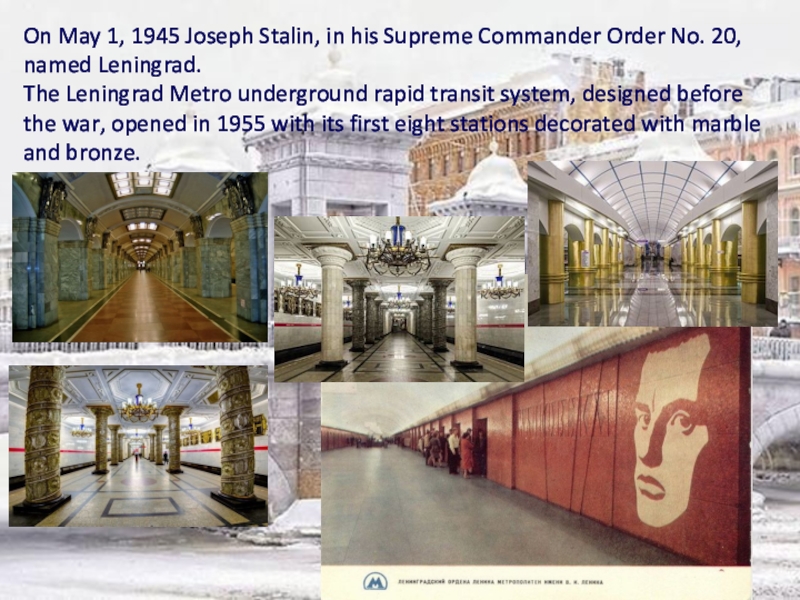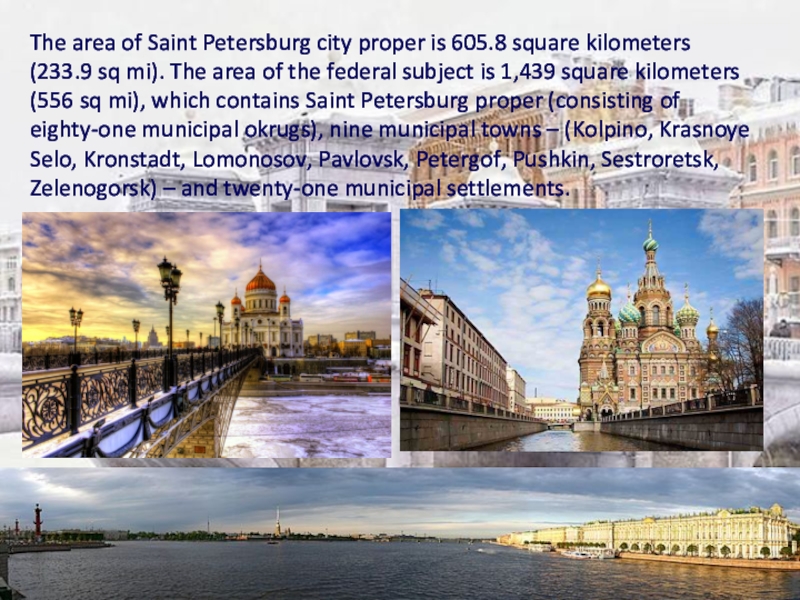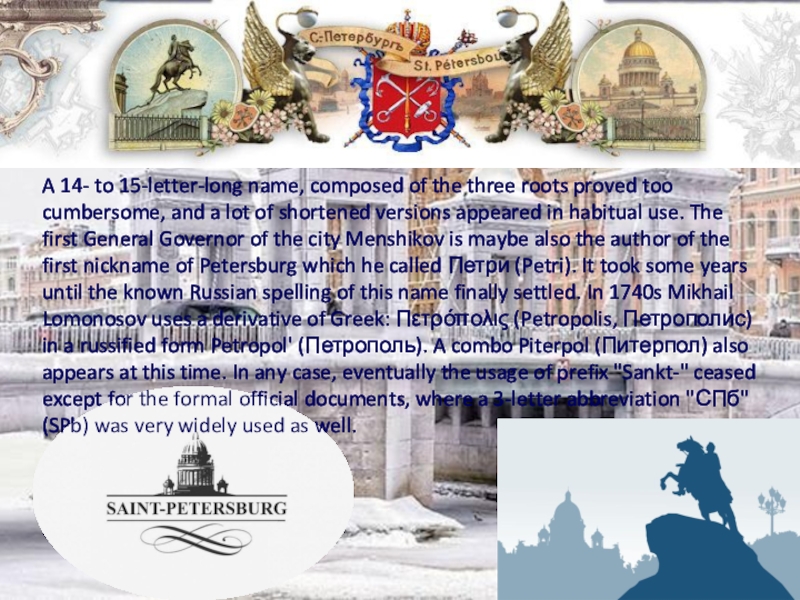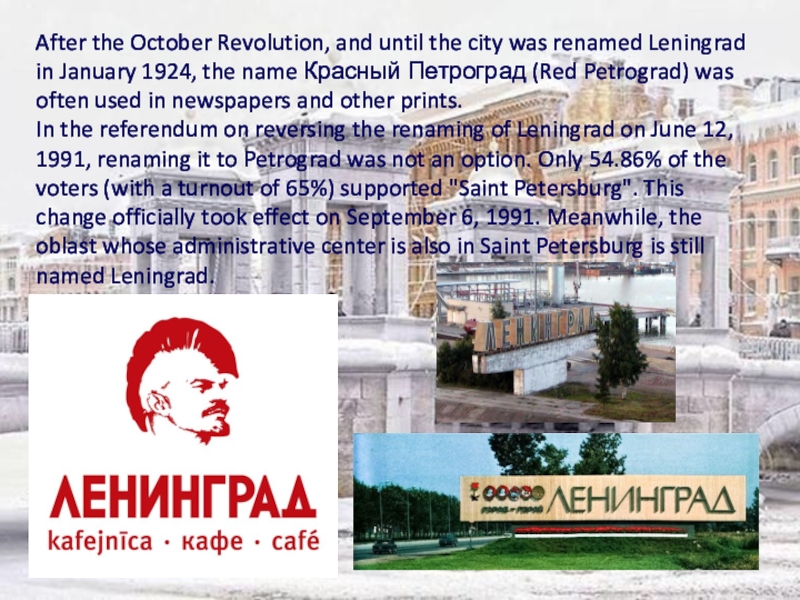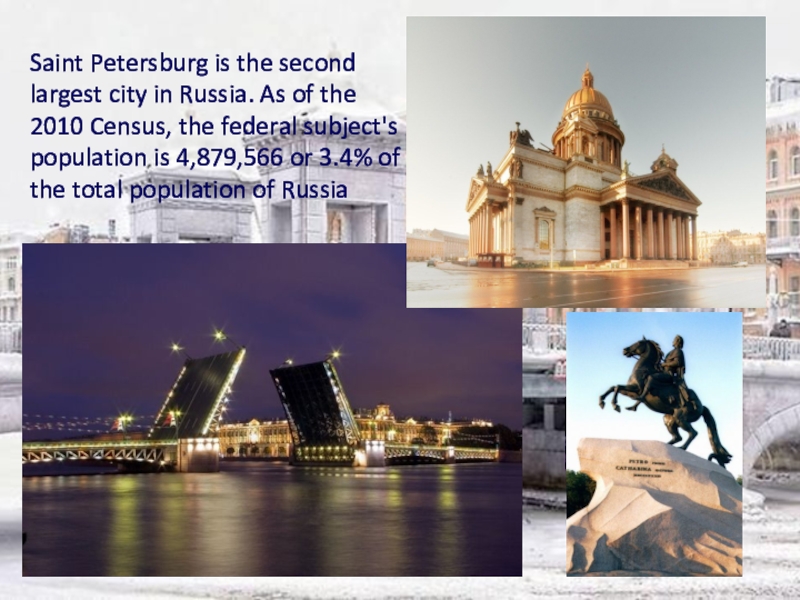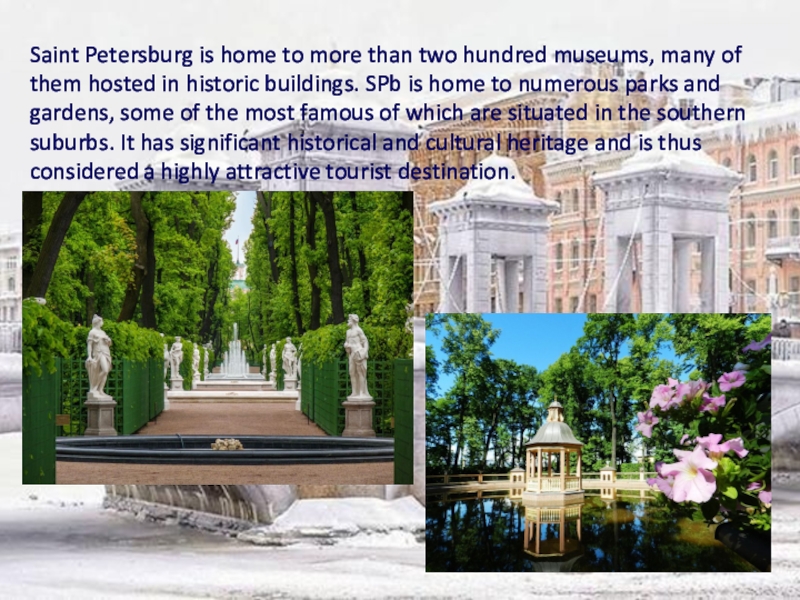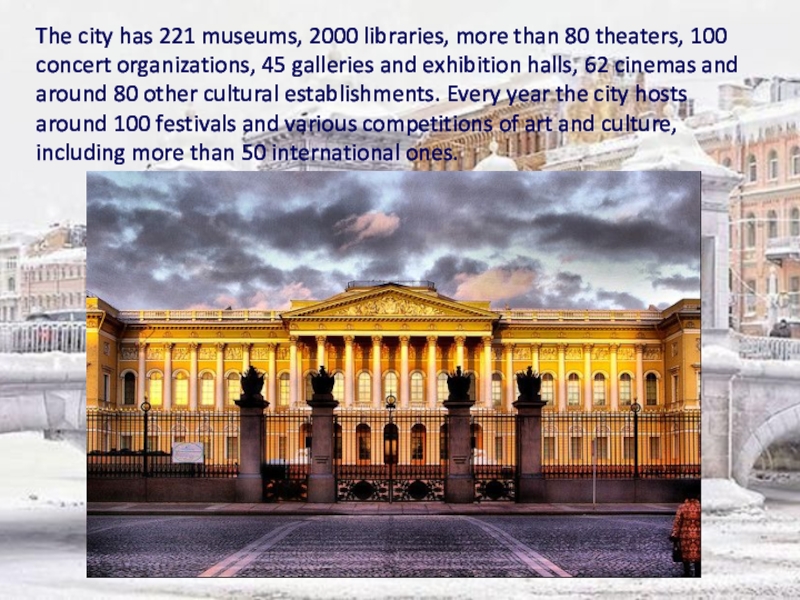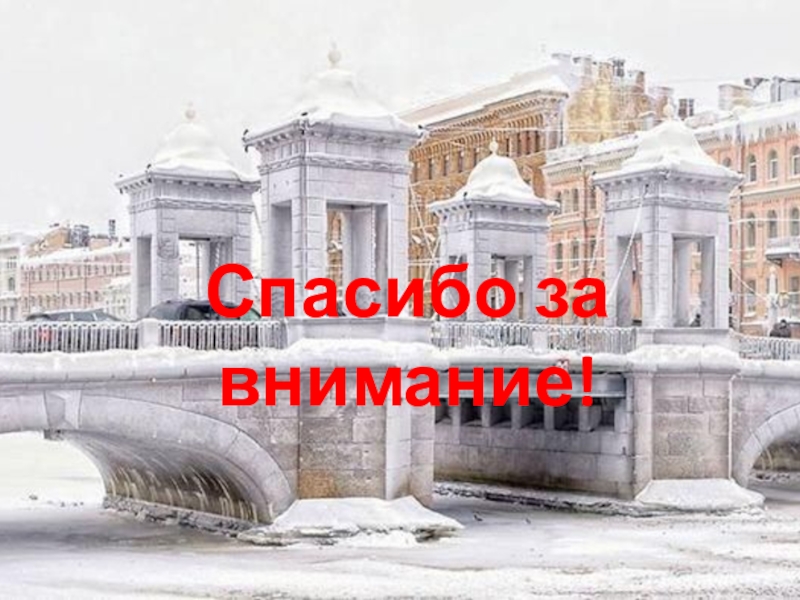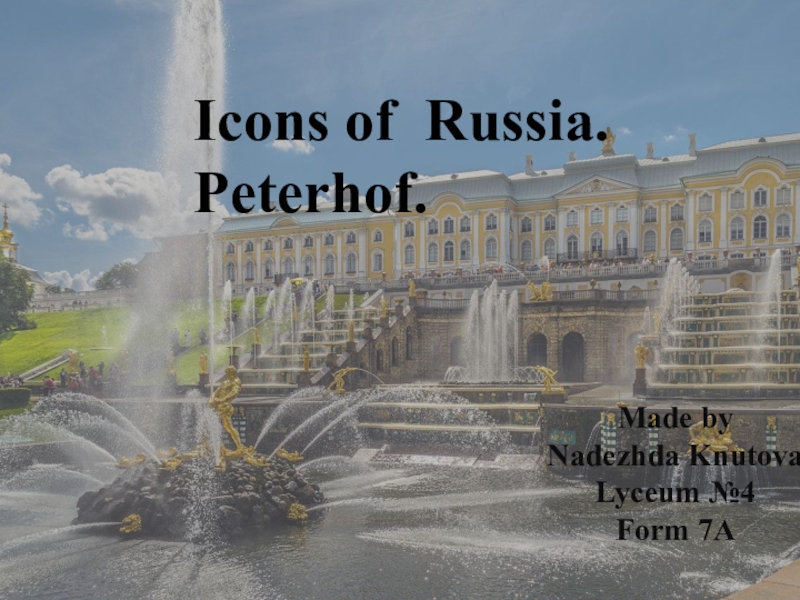- Главная
- Разное
- Образование
- Спорт
- Естествознание
- Природоведение
- Религиоведение
- Французский язык
- Черчение
- Английский язык
- Астрономия
- Алгебра
- Биология
- География
- Геометрия
- Детские презентации
- Информатика
- История
- Литература
- Математика
- Музыка
- МХК
- Немецкий язык
- ОБЖ
- Обществознание
- Окружающий мир
- Педагогика
- Русский язык
- Технология
- Физика
- Философия
- Химия
- Шаблоны, фоны, картинки для презентаций
- Экология
- Экономика
Презентация, доклад на Английском языке: Saint Petersburg.
Содержание
- 1. Презентация на Английском языке: Saint Petersburg.
- 2. Saint Petersburg is the second largest city
- 3. Tsar Peter the Great founded Saint Petersburg
- 4. Saint Petersburg is often described as the
- 5. Swedish colonists built Nyenskans, a fortress, at
- 6. During its first few years, the city
- 7. The style of Petrine Baroque, developed by
- 8. In 1736–1737 the city suffered from catastrophic
- 9. It developed along three radial streets, which
- 10. The Revolution of 1905 began in Saint
- 11. On May 1, 1945 Joseph Stalin, in
- 12. The area of Saint Petersburg city proper
- 13. A 14- to 15-letter-long name, composed of
- 14. After the October Revolution, and until the
- 15. Saint Petersburg is the second largest city
- 16. Saint Petersburg is home to more than
- 17. The city has 221 museums, 2000 libraries,
- 18. Спасибо за внимание!
Saint Petersburg is the second largest city in Russia. It is politically incorporated as a federal subject (a federal city). It is located on the Neva River at the head of the Gulf of Finland on
Слайд 2Saint Petersburg is the second largest city in Russia. It is
politically incorporated as a federal subject (a federal city). It is located on the Neva River at the head of the Gulf of Finland on the Baltic Sea. It was named Saint Petersburg in 1703. In 1914 the name of the city was changed from Saint Petersburg to Petrograd, in 1924 to Leningrad, and in 1991, back to Saint Petersburg. In Russian literature, informal documents, and discourse, the word "Saint" is usually omitted, leaving "Petersburg". In casual conversation Russians may drop the "burg" as well, referring to it as "Peter".
Слайд 3Tsar Peter the Great founded Saint Petersburg on May 27 1703.
Between 1713–1728 and 1732–1918 Saint Petersburg functioned as the imperial capital of Russia. In 1918 the central government bodies moved from Saint Petersburg (then named Petrograd) to Moscow. It is Russia's second-largest city after Moscow, with 5 million inhabitants (2012), and the fourth most populated federal subject. Saint Petersburg is a major European cultural center, and also an important Russian port on the Baltic Sea.
Слайд 4Saint Petersburg is often described as the most Westernized city of
Russia, as well as its cultural capital. It is the northernmost city in the world with a population of over one million. The Historic Centre of Saint Petersburg and Related Groups of Monuments constitute a UNESCO World Heritage Site. Saint Petersburg is home to The Hermitage, one of the largest art museums in the world. A large number of foreign consulates, international corporations, banks, and businesses have offices in Saint Petersburg.
Слайд 5Swedish colonists built Nyenskans, a fortress, at the mouth of the
Neva River in 1611, in a land then called Ingermanland, that was inhabited by Finnic tribe of Ingrians. A small town called "Nyen" grew up around it.
Peter the Great was interested in seafaring and maritime affairs, and he intended to have Russia gain a seaport in order to be able to trade with other maritime nations.
The city was built by conscripted peasants from all over Russia; a number of Swedish prisoners of war were also involved in some years under the supervision of Alexander Menshikov.
Peter the Great was interested in seafaring and maritime affairs, and he intended to have Russia gain a seaport in order to be able to trade with other maritime nations.
The city was built by conscripted peasants from all over Russia; a number of Swedish prisoners of war were also involved in some years under the supervision of Alexander Menshikov.
Слайд 6During its first few years, the city developed around Trinity Square
on the right bank of the Neva, near the Peter and Paul Fortress. However, Saint Petersburg soon started to be built out according to a plan. By 1716 Domenico Trezzini had elaborated a
project whereby the city centre would be located on Vasilyevsky Island and shaped by a rectangular grid of canals.
Слайд 7The style of Petrine Baroque, developed by Trezzini and other architects
and exemplified by such buildings as the Menshikov Palace, Kunstkamera, Peter and Paul Cathedral, Twelve Collegia, became prominent in the city architecture of the early 18th century. In 1724 the Academy of Sciences, University and Academic Gymnasium were established in Saint Petersburg by Peter the Great.
Слайд 8In 1736–1737 the city suffered from catastrophic fires. The city was
divided into five boroughs, and the city center was moved to the Admiralty borough, situated on the east bank between the Neva and Fontanka.
Слайд 9It developed along three radial streets, which meet at the Admiralty
building and are now one street known as Nevsky Prospekt, Gorokhovaya Street and Voznesensky Prospekt. Baroque architecture became dominant in the city during the first sixty years, culminating in the Elizabethan Baroque, represented most notably by Bartolomeo Rastrelli with such buildings as the Winter Palace. In the 1760s, Baroque architecture was succeeded by neoclassical architecture.
Слайд 10The Revolution of 1905 began in Saint Petersburg and spread rapidly
into the provinces.
On September 1, 1914, after the outbreak of World War I, the Imperial government renamed the city Petrograd, meaning "Peter's City", to remove the German words Sankt and Burg.
During World War II, German forces besieged Leningrad following the Axis invasion of the Soviet Union in June 1941. The siege lasted 872 days,from September 1941 to January 1944. The Siege of Leningrad proved one of the longest, most destructive, and most lethal sieges of a major city in modern history.
On September 1, 1914, after the outbreak of World War I, the Imperial government renamed the city Petrograd, meaning "Peter's City", to remove the German words Sankt and Burg.
During World War II, German forces besieged Leningrad following the Axis invasion of the Soviet Union in June 1941. The siege lasted 872 days,from September 1941 to January 1944. The Siege of Leningrad proved one of the longest, most destructive, and most lethal sieges of a major city in modern history.
Слайд 11On May 1, 1945 Joseph Stalin, in his Supreme Commander Order
No. 20, named Leningrad.
The Leningrad Metro underground rapid transit system, designed before the war, opened in 1955 with its first eight stations decorated with marble and bronze.
The Leningrad Metro underground rapid transit system, designed before the war, opened in 1955 with its first eight stations decorated with marble and bronze.
Слайд 12The area of Saint Petersburg city proper is 605.8 square kilometers
(233.9 sq mi). The area of the federal subject is 1,439 square kilometers (556 sq mi), which contains Saint Petersburg proper (consisting of eighty-one municipal okrugs), nine municipal towns – (Kolpino, Krasnoye Selo, Kronstadt, Lomonosov, Pavlovsk, Petergof, Pushkin, Sestroretsk, Zelenogorsk) – and twenty-one municipal settlements.
Слайд 13A 14- to 15-letter-long name, composed of the three roots proved
too cumbersome, and a lot of shortened versions appeared in habitual use. The first General Governor of the city Menshikov is maybe also the author of the first nickname of Petersburg which he called Петри (Petri). It took some years until the known Russian spelling of this name finally settled. In 1740s Mikhail Lomonosov uses a derivative of Greek: Πετρόπολις (Petropolis, Петрополис) in a russified form Petropol' (Петрополь). A combo Piterpol (Питерпол) also appears at this time. In any case, eventually the usage of prefix "Sankt-" ceased except for the formal official documents, where a 3-letter abbreviation "СПб" (SPb) was very widely used as well.
Слайд 14After the October Revolution, and until the city was renamed Leningrad
in January 1924, the name Красный Петроград (Red Petrograd) was often used in newspapers and other prints.
In the referendum on reversing the renaming of Leningrad on June 12, 1991, renaming it to Petrograd was not an option. Only 54.86% of the voters (with a turnout of 65%) supported "Saint Petersburg". This change officially took effect on September 6, 1991. Meanwhile, the oblast whose administrative center is also in Saint Petersburg is still named Leningrad.
In the referendum on reversing the renaming of Leningrad on June 12, 1991, renaming it to Petrograd was not an option. Only 54.86% of the voters (with a turnout of 65%) supported "Saint Petersburg". This change officially took effect on September 6, 1991. Meanwhile, the oblast whose administrative center is also in Saint Petersburg is still named Leningrad.
Слайд 15Saint Petersburg is the second largest city in Russia. As of
the 2010 Census, the federal subject's population is 4,879,566 or 3.4% of the total population of Russia
Слайд 16Saint Petersburg is home to more than two hundred museums, many
of them hosted in historic buildings. SPb is home to numerous parks and gardens, some of the most famous of which are situated in the southern suburbs. It has significant historical and cultural heritage and is thus considered a highly attractive tourist destination.
Слайд 17The city has 221 museums, 2000 libraries, more than 80 theaters,
100 concert organizations, 45 galleries and exhibition halls, 62 cinemas and around 80 other cultural establishments. Every year the city hosts around 100 festivals and various competitions of art and culture, including more than 50 international ones.
